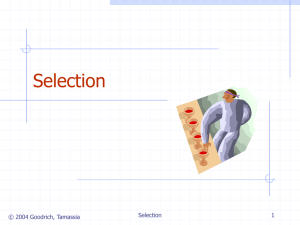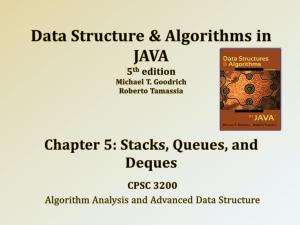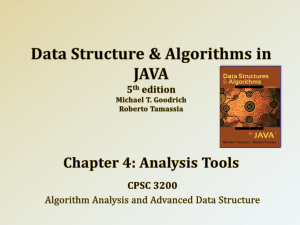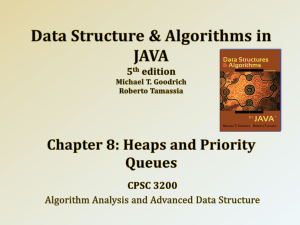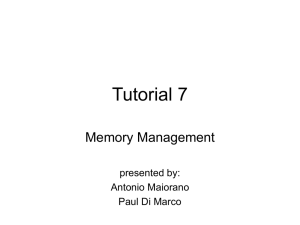quicksort
advertisement
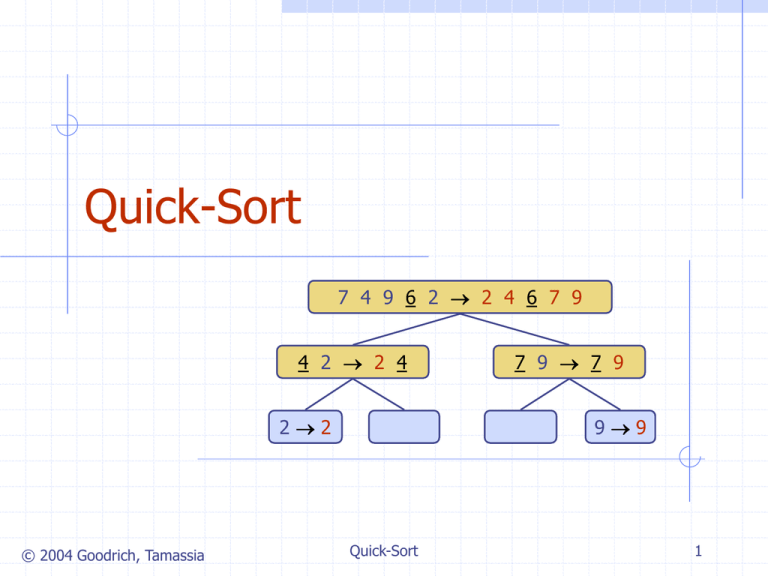
Quick-Sort
7 4 9 6 2 2 4 6 7 9
4 2 2 4
22
© 2004 Goodrich, Tamassia
7 9 7 9
99
Quick-Sort
1
Quick-Sort
Quick-sort is a randomized
sorting algorithm based
on the divide-and-conquer
paradigm:
x
Divide: pick a random
element x (called pivot) and
partition S into
x
L elements less than x
L
E elements equal x
E
G
G elements greater than x
Recur: sort L and G
Conquer: join L, E and G
© 2004 Goodrich, Tamassia
Quick-Sort
x
2
Partition
We partition an input
sequence as follows:
We remove, in turn, each
element y from S and
We insert y into L, E or G,
depending on the result of
the comparison with the
pivot x
Each insertion and removal
is at the beginning or at the
end of a sequence, and
hence takes O(1) time
Thus, the partition step of
quick-sort takes O(n) time
© 2004 Goodrich, Tamassia
Algorithm partition(S, p)
Input sequence S, position p of pivot
Output subsequences L, E, G of the
elements of S less than, equal to,
or greater than the pivot, resp.
L, E, G empty sequences
x S.remove(p)
while S.isEmpty()
y S.remove(S.first())
if y < x
L.addLast(y)
else if y = x
E.addLast(y)
else { y > x }
G.addLast(y)
return L, E, G
Quick-Sort
3
Quick-Sort Tree
An execution of quick-sort is depicted by a binary tree
Each node represents a recursive call of quick-sort and stores
Unsorted sequence before the execution and its pivot
Sorted sequence at the end of the execution
The root is the initial call
The leaves are calls on subsequences of size 0 or 1
7 4 9 6 2 2 4 6 7 9
4 2 2 4
7 9 7 9
22
© 2004 Goodrich, Tamassia
99
Quick-Sort
4
Execution Example
Pivot selection
7 2 9 43 7 6 1 1 2 3 4 6 7 8 9
7 2 9 4 2 4 7 9
22
9 4 4 9
99
© 2004 Goodrich, Tamassia
3 8 6 1 1 3 8 6
33
88
44
Quick-Sort
5
Execution Example (cont.)
Partition, recursive call, pivot selection
7 2 9 4 3 7 6 1 1 2 3 4 6 7 8 9
2 4 3 1 2 4 7 9
22
9 4 4 9
99
© 2004 Goodrich, Tamassia
3 8 6 1 1 3 8 6
33
88
44
Quick-Sort
6
Execution Example (cont.)
Partition, recursive call, base case
7 2 9 43 7 6 1 1 2 3 4 6 7 8 9
2 4 3 1 2 4 7
11
9 4 4 9
99
© 2004 Goodrich, Tamassia
3 8 6 1 1 3 8 6
33
88
44
Quick-Sort
7
Execution Example (cont.)
Recursive call, …, base case, join
7 2 9 43 7 6 1 1 2 3 4 6 7 8 9
2 4 3 1 1 2 3 4
11
4 3 3 4
99
© 2004 Goodrich, Tamassia
3 8 6 1 1 3 8 6
33
88
44
Quick-Sort
8
Execution Example (cont.)
Recursive call, pivot selection
7 2 9 43 7 6 1 1 2 3 4 6 7 8 9
2 4 3 1 1 2 3 4
11
4 3 3 4
99
© 2004 Goodrich, Tamassia
7 9 7 1 1 3 8 6
88
99
44
Quick-Sort
9
Execution Example (cont.)
Partition, …, recursive call, base case
7 2 9 43 7 6 1 1 2 3 4 6 7 8 9
2 4 3 1 1 2 3 4
11
4 3 3 4
99
© 2004 Goodrich, Tamassia
7 9 7 1 1 3 8 6
88
99
44
Quick-Sort
10
Execution Example (cont.)
Join, join
7 2 9 4 3 7 6 1 1 2 3 4 6 7 7 9
2 4 3 1 1 2 3 4
11
4 3 3 4
99
© 2004 Goodrich, Tamassia
7 9 7 17 7 9
88
99
44
Quick-Sort
11
Worst-case Running Time
The worst case for quick-sort occurs when the pivot is the unique
minimum or maximum element
One of L and G has size n - 1 and the other has size 0
The running time is proportional to the sum
n + (n - 1) + … + 2 + 1
Thus, the worst-case running time of quick-sort is O(n2)
depth time
© 2004 Goodrich, Tamassia
0
n
1
n-1
…
…
n-1
1
Quick-Sort
12
Expected Running Time
Consider a recursive call of quick-sort on a sequence of size s
Good call: the sizes of L and G are each less than 3s/4
Bad call: one of L and G has size greater than 3s/4
7 2 9 43 7 6 1
7 2 9 43 7 6 19
7 9 7 1 1
2 4 3 1
1
7294376
Good call
Bad call
A call is good with probability 1/2
1/2 of the possible pivots cause good calls:
1 2 3 4 5 6 7 8 9 10 11 12 13 14 15 16
Bad pivots
© 2004 Goodrich, Tamassia
Good pivots
Quick-Sort
Bad pivots
13
Expected Running Time, Part 2
Probabilistic Fact: The expected number of coin tosses required in
order to get k heads is 2k
For a node of depth i, we expect
i/2 ancestors are good calls
The size of the input sequence for the current call is at most (3/4)i/2n
Therefore, we have
time per level
O(n)
expected height
s(r)
For a node of depth 2log4/3n,
the expected input size is one
The expected height of the
quick-sort tree is O(log n)
The amount or work done at the
nodes of the same depth is O(n)
Thus, the expected running time
of quick-sort is O(n log n)
s(a)
s(b)
O(n)
O(log n)
s(c)
s(d)
s(e)
s(f)
O(n)
total expected time: O(n log n)
© 2004 Goodrich, Tamassia
Quick-Sort
14
In-Place Quick-Sort
Quick-sort can be implemented
to run in-place
Algorithm inPlaceQuickSort(S, l, r)
In the partition step, we use
Input sequence S, ranks l and r
replace operations to rearrange
Output sequence S with the
the elements of the input
elements of rank between l and r
sequence such that
the elements less than the
pivot have rank less than h
the elements equal to the pivot
have rank between h and k
the elements greater than the
pivot have rank greater than k
The recursive calls consider
elements with rank less than h
elements with rank greater
than k
© 2004 Goodrich, Tamassia
Quick-Sort
rearranged in increasing order
if l r
return
i a random integer between l and r
x S.elemAtRank(i)
(h, k) inPlacePartition(x)
inPlaceQuickSort(S, l, h - 1)
inPlaceQuickSort(S, k + 1, r)
15
In-Place Partitioning
Perform the partition using two indices to split S into L
and E U G (a similar method can split E U G into E and G).
j
k
3 2 5 1 0 7 3 5 9 2 7 9 8 9 7 6 9
(pivot = 6)
Repeat until j and k cross:
Scan j to the right until finding an element > x.
Scan k to the left until finding an element < x.
Swap elements at indices j and k
j
k
3 2 5 1 0 7 3 5 9 2 7 9 8 9 7 6 9
© 2004 Goodrich, Tamassia
Quick-Sort
16
Summary of Sorting Algorithms
Algorithm
Time
Notes
selection-sort
O(n2)
in-place
slow (good for small inputs)
insertion-sort
O(n2)
in-place
slow (good for small inputs)
quick-sort
O(n log n)
expected
in-place, randomized
fastest (good for large inputs)
O(n log n)
in-place
fast (good for large inputs)
O(n log n)
sequential data access
fast (good for huge inputs)
heap-sort
merge-sort
© 2004 Goodrich, Tamassia
Quick-Sort
17
